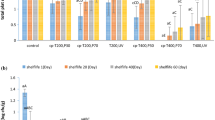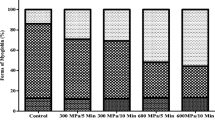Abstract
The feasibility of supercritical carbon dioxide (SC-CO2) treatment to inactivate Listeria monocytogenes inoculated on the surface of dry cured ham was investigated. A multibatch apparatus was used. Inactivation kinetics were determined at 8 and 12 MPa, as a function of temperatures (35–50 °C), treatment times (5–60 min), and initial microbial loads (103–107 colony-forming units [CFU]/g). Color changes of the sample were determined by measuring the reflectance spectra and L*, a*, and b* parameters. A new spectroscopic technique was developed for this. Sensory quality of the product before and after the SC-CO2 treatment was evaluated by a sensory panel. Treatment at 50 °C, 12 MPa for 15 min resulted in total inactivation of L. monocytogenes with an initial microbial load of 107 CFU/g. Less severe conditions, e.g., 45 °C, 12 MPa, 5 min, were sufficient to reach total inactivation if the initial microbial load was 103 CFU/g. The process slightly influenced the color and sensory attributes of the sample. The results demonstrated the efficiency and the potential of SC-CO2 as a technology for the pasteurization of the surface of foods, in particular ham-type meat products.





Similar content being viewed by others
References
ANZFA. (2001). Recall guidelines for packaged ready-to-eat foods found to contain Listeria monocytogenes at point of sale. Arkansas: Faculty Impact Statements.
Apruzzese, F., Balke, S. T., & Diosady, L. L. (2000). In-line colour and composition monitoring in the extrusion cooking process. Food Research International, 33, 621–628.
Blickstad, E., Enfors, S. O., & Molin, G. (1981). Effect of hyperbaric carbon dioxide pressure on the microbial flora of pork stored at 4 or 14 °C. Journal of Applied Bacteriology, 50, 493–504.
Bover-Cid, S., Belletti, N., Garriga, M., & Aymerich, T. (2011). Model for Listeria monocytogenes inactivation on dry-cured ham by high hydrostatic pressure processing. Food Microbiology, 28, 804–809.
Calvo, L., & Torres, E. (2010). Microbial inactivation of paprika using high-pressure CO2. Journal of Supercritical Fluids, 52, 134–141.
CFSAN/FSIS. (2003). Quantitative assessment of relative risk to public health from foodborne Listeria monocytogenes among selected categories of ready-to-eat foods. Silver Spring: Food and Drug Administration.
Cheftel, J. C. (1995). High-pressure, microbial inactivation and food preservation. Food Science and Technology International, 1, 75–90.
Choi, Y. M., Bae, Y. Y., Kim, K. H., Kim, B. C., & Rhee, M. S. (2009). Effects of supercritical carbon dioxide treatment against generic Escherichia coli, Listeria monocytogenes, Salmonella typhimurium, and E. coli O157:H7 in marinades and marinated pork. Meat Science, 82, 419–424.
Commission, E. (2005). Regulation (EC) no 2073/2005 of 15 November 2005 on microbiological criteria for foodstuffs. Official Journal of the European Union, 338, 1–26.
Damar, S., & Balaban, M. O. (2006). Review of dense phase CO2 technology: Microbial and enzyme inactivation, and effects on food quality. Journal of Food Science, 71, R1–R11.
Daniels, J. A., Krishnamurthi, R., & Rizvi, S. S. H. (1985). A review of effects of carbon dioxide on microbial growth and food quality. Journal of Food Protection, 48, 532–537.
Dodds, W. S., Stutzman, L. F., & Sollami, B. J. (1956). Carbon dioxide solubility in water. Industrial and Engineering Chemistry, 1, 92–95.
Enfors, S. O., & Molin, G. (1980). Effect of high concentrations of carbon dioxide on growth rate of Pseudomonas fragi, Bacillus cereus and Streptococcus cremoris. Journal of Applied Bacteriology, 48, 409–416.
Erkmen, O. (2000a). Inactivation of Salmonella typhimurium by high pressure carbon dioxide. Food Microbiology, 17, 225–232.
Erkmen, O. (2000b). Antimicrobial effect of pressurised carbon dioxide on Enterococcus faecalis in physiological saline and foods. Journal of the Science of Food and Agriculture, 80, 465–470.
Erkmen, O. (2000c). Effect of carbon dioxide pressure on Listeria monocytogenes in physiological saline and foods. Food Microbiology, 17, 589–596.
European Food Safety Authority. (2010). The Community Summary Report on trends and sources of zoonoses, zoonotic agents and food-borne outbreaks in the European Union in 2008. EFSA J., 1496, 1–288.
Ferrentino, G., & Spilimbergo, S. (2011). High pressure carbon dioxide pasteurization of solid foods: Current knowledge and future outlooks. Trends in Food Science and Technology, 22, 427–441.
Ferrentino, G., Balaban, M. O., Ferrari, G., & Poletto, M. (2010). Food treatment with high pressure carbon dioxide: Saccharomyces cerevisiae inactivation kinetics expressed as a function of CO2 solubility. Journal of Supercritical Fluids, 52, 151–160.
Ferrentino, G., Balzan, S., & Spilimbergo, S. (2012). On-line color monitoring of solid foods during supercritical CO2 pasteurization. Journal of Food Engineering, 110, 80–85.
Franciosa, G., Tartaro, S., Wedell-Neergaard, C., & Aureli, P. (2001). Characterization of L. monocytogenes strains involved in invasive and non-invasive listeriosis outbreaks by PCR-based fingerprinting techniques. Applied and Environmental Microbiology, 67, 1793–1799.
Garcia-Gonzalez, L., Geeraerd, A. H., Spilimbergo, S., Elst, K., Van Ginneken, L., Debevere, J., Van Impe, J. F., & Devlieghere, F. (2007). High pressure carbon dioxide inactivation of microorganisms in foods: The past, the present and the future. International Journal of Food Microbiology, 117, 1–28.
Global Industry Analysts, Inc. (2010). A global strategic business report (pp. 1–538). San Jose: Global Industry Analysts, Inc.
Gola, S., Frustoli, M., Rovere, P., & Miglioli, L. (2003). Inattivazione di Listeria monocytogenes in prosciutto crudo trattato con la pressione idrostatica [Inactivation of Listeria monocytogenes in dry cured ham by hydrostatic pressure treatment]. Industria Conserve, 78, 441–449.
Grisenti, M. S., Lori, D., Vicini, L., Bovis, N., Pedrelli, B., & Barbuti, S. (2004). Comportamento di Listeria monocytogenes in prosciutto crudo stagionato in rapporto all’atmosfera di confezionamento e alla temperatura di conservazione [Behavior of Listeria monocytogenes in dry cured ham depending on the packaging atmosphere and storage temperature]. Industria Conserve, 79, 3–12.
Hong, S. I., Park, W. S., & Pyun, Y. R. (1997). Inactivation of Lactobacillus sp. from kimchi by high pressure carbon dioxide. Lebensmittel-Wissenschaft und Technologie, 30, 681–685.
Hunter, R., Harold R. W. (1975). The measurement of appearance. (2nd ed.) New York: Wiley-Interscience.
International Commission of Microbial Specifications of Food (ICMSF). (1996). Microbiological specifications of food pathogens. In T. A. Roberts, A. C. Baird-Parker, & R. B. Tompkin (Eds.), Microorganisms in foods 5 (pp. 141–182). London: Blackie Academic & Professional.
Kim, J. G., Yousef, A. E., & Dave, S. (1999). Application of ozone for enhancing the microbiological safety and quality of foods: A review. Journal of Food Protection, 62, 1071–1087.
Komes, D., Belščak-Cvitanović, A., Horžić, D., Drmić, H., Škrabal, S., & Miličević, B. (2011). Bioactive and sensory properties of herbal spirit enriched with cocoa (Theobroma cacao L.) polyphenolics. Food Bioprocess Technology. doi:10.1007/s11947-011-0630-7.
Lin, H. M., Cao, N. J., & Chen, L. F. (1994). Antimicrobial effect of pressurized carbon dioxide on Listeria monocytogenes. Journal of Food Science, 59, 657–659.
Martìn, A., Benito, M. J., Hernández, A., Pérez-Nevado, F., Córdoba, J. J., & Córdoba, M. G. (2008). Characterization of microbial deep spoilage in Iberian dry-cured ham. Meat Science, 78, 475–484.
Mazzoni, A. M., Sharma, R. R., Demerci, A., & Ziegler, G. R. (2001). Supercritical carbon dioxide treatment to inactivate aerobic microorganisms on alfalfa seeds. Journal of Food Safety, 21, 215–223.
McLauchlin, J. (1997). The pathogenicity of Listeria monocytogenes. A public health perspective. Reviews in Medical Microbiology, 8, 1–14.
Minei, C. C., Gomes, B. C., Ratti, R. P., D’Angelis, C. E. M., & De Martinis, E. C. P. (2008). Influence of peroxyacetic acid and nisin and coculture with Enterococcus faecium on Listeria monocytogenes biofilm formation. Journal of Food Protection, 71, 634–638.
Molin, G. (1983). The resistance to carbon dioxide of some food related bacteria. Applied Microbiology and Biotechnology, 18, 214–217.
Pataro, G., Ferrentino, G., Ricciardi, C., & Ferrari, G. (2010). Pulsed electric fields assisted microbial inactivation of S. cerevisiae cells by high pressure carbon dioxide. Journal of Supercritical Fluids, 54, 120–128.
Quintavalla, S., & Vicini, L. (2002). Antimicrobial food packaging in meat industry. Meat Science, 62, 373–380.
Ramirez-Rodrigues, M. M., Plaza, M. L., Ferrentino, G., Balaban, M. O., Reyes-De Concuera, J. I., & Marshall, M. R. (2011). Effect of dense phase carbon dioxide processing on microbial stability and physicochemical attributes of Hibiscus sabdariffa beverage. Journal of Food Process Engineering. doi:10.1111/j.1745-4530.2011.00663.x.
Ray, B. (1979). Methods to detect stressed microorganisms. Journal of Food Protection, 42, 346–355.
Reynolds, A. E., Harrison, M. A., Rose-Morrow, R., & Lyon, C. E. (2001). Validation of dry cured ham process for control of pathogens. Journal of Food Science, 66, 1373–1379.
Shabala, L., Lee, S. H., Cannesson, P., & Ross, T. (2008). Acid and NaCl limits to growth of Listeria monocytogenes and influence of sequence of inimical acid and NaCl levels on inactivation kinetics. Journal of Food Protection, 71, 1169–1177.
Spilimbergo, S., & Bertucco, A. (2003). Non-thermal bacteria inactivation with dense CO2. Biotechnology and Bioengineering, 84, 627–638.
Spilimbergo, S., Bertucco, A., Basso, G., & Bertoloni, G. (2005). Determination of extracellular and intracellular pH of Bacillus subtilis suspension under CO2 treatment. Biotechnology and Bioengineering, 92, 447–451.
Tahiri, I., Makhlouf, J., Paquin, P., & Fliss, I. (2006). Inactivation of food spoilage bacteria and Escherichia coli O157:H7 in phosphate buffer and orange juice using dynamic high pressure. Food Research International, 39, 98–105.
Tassou, C. C., Panagou, E. Z., Samaras, F. J., Galiatsatou, P., & Mallidis, C. G. (2008). Temperature-assisted high hydrostatic pressure inactivation of Staphylococcus aureus in a ham model system: Evaluation in selective and nonselective medium. Journal of Applied Microbiology, 104, 1764–1773.
Toldrá, F. (2004). Dry-cured ham meat products. New York: Wiley-Blackwell.
Tompkin, R. B. (2002). Control of Listeria monocytogenes in the food processing environment. Journal of Food Protection, 65, 709–725.
Turgis, M., Han, J., Borsa, J., & Lacroix, M. (2008). Combined effect of natural essential oils, modified atmosphere packaging and gamma radiation on the microbial growth on ground beef. Journal of Food Protection, 71, 1237–1243.
Valverde, M. T., Marin-Iniesta, M. T., & Calvo, L. (2010). Inactivation of Saccharomyces cerevisiae in conference pear with high pressure carbon dioxide and effects on pear quality. Journal of Food Engineering, 98, 421–428.
Zhang, J., Davis, T. A., Matthews, M. A., Drews, M. J., LaBerge, M., & An, Y. H. H. (2006). Sterilization using high-pressure carbon dioxide. Journal of Supercritical Fluids, 38, 354–372.
Acknowledgements
This research was funded by the European Community’s Seventh Framework Program (FP7/2007-2013) under grant agreement no. 245280, also known by the acronym PRESERF “Processing Raw Materials into Excellent and Sustainable End products while Remaining Fresh.”
Author information
Authors and Affiliations
Corresponding author
Rights and permissions
About this article
Cite this article
Ferrentino, G., Balzan, S. & Spilimbergo, S. Supercritical Carbon Dioxide Processing of Dry Cured Ham Spiked with Listeria monocytogenes: Inactivation Kinetics, Color, and Sensory Evaluations. Food Bioprocess Technol 6, 1164–1174 (2013). https://doi.org/10.1007/s11947-012-0819-4
Received:
Accepted:
Published:
Issue Date:
DOI: https://doi.org/10.1007/s11947-012-0819-4




